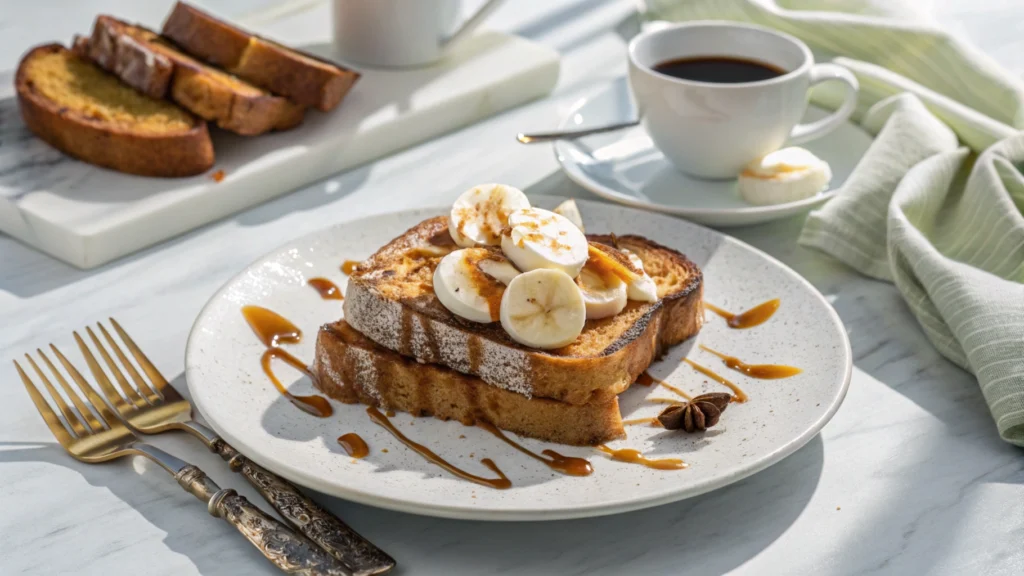Sourdough French toast is the perfect combination of crispy, golden edges and a soft, custardy center. The slight tang of sourdough bread, paired with warm cinnamon, vanilla, and a hint of sweetness, makes for an irresistible breakfast or brunch treat. Whether you’re craving a cozy weekend meal or looking for a delicious way to use up leftover bread, this recipe delivers the ideal balance of flavor and texture.
In this guide, we’ll walk you through everything you need to make the best sourdough French toast—from choosing the right ingredients to mastering the cooking process. We’ll also share creative topping ideas, expert tips, and answers to common questions. Plus, we’ll show you the best methods for freezing and reheating so you can enjoy this dish anytime.
Get ready for a step-by-step breakdown, flavor variations for every preference, and pro tips to ensure your sourdough French toast turns out perfect every time. Let’s get started!
Article Outline
Why Sourdough is Perfect for French Toast
A great French toast recipe starts with the right bread, and sourdough is an unbeatable choice. It adds a unique tangy flavor, a sturdy texture, and a beautifully crisp exterior that makes every bite irresistible. Unlike soft white bread, which can become too mushy when soaked, sourdough bread holds up well, ensuring the perfect balance between crispy edges and a custardy center.
The Unique Texture and Flavor of Sourdough
What makes sourdough French toast so special? It’s all about the texture and flavor. Sourdough bread is naturally firmer and has a slightly chewy crust, which means it won’t fall apart in the egg mixture. This results in French toast with a delightful golden-brown crunch on the outside while remaining soft and creamy inside.
In addition, sourdough has a mild tangy taste due to the fermentation process, giving your French toast a deeper, more complex flavor. This subtle sourness balances beautifully with sweet toppings like maple syrup, honey, or fruit compote, making every bite more exciting than plain white bread French toast.
Why Day-Old Bread Works Best
Want to take your sourdough French toast recipe to the next level? Use day-old bread! Fresh sourdough is wonderful for sandwiches, but when it comes to French toast, slightly stale bread is ideal.
Here’s why:
✔️ Better Absorption – Day-old sourdough absorbs the egg mixture evenly without getting too soggy.
✔️ Improved Texture – The slightly dried-out crust helps create a crispier outer layer when cooked.
✔️ Less Waste – It’s a fantastic way to use up leftover bread that might otherwise go stale.
If your sourdough is fresh, no worries! Simply slice it and leave it out for a few hours or lightly toast it before soaking.
Health Benefits of Sourdough Bread
Beyond taste and texture, sourdough is a healthier choice compared to regular white bread. Thanks to its natural fermentation process, it’s packed with benefits:
Rich in Probiotics – The live cultures in sourdough bread support gut health, promoting better digestion.
Easier to Digest – The fermentation breaks down gluten, making it gentler on the stomach.
Essential Ingredients for Sourdough French Toast
A great sourdough French toast recipe starts with simple, high-quality ingredients. The beauty of this dish lies in its balance—rich, custardy bread with a slightly crisp exterior and a hint of sweetness. With the right ingredients, you’ll create a breakfast that’s both indulgent and comforting.
Must-Have Ingredients for the Best Sourdough French Toast
To make this recipe shine, gather the following essentials:
- 4 slices of sourdough bread – Thick-cut, preferably day-old, for the perfect texture.
- 4 large eggs – Creates a rich custard base that binds the flavors together.
- 1 cup whole milk – Adds creaminess and ensures a soft, moist interior.
- ¼ cup brown sugar – Enhances caramelization and gives a deep sweetness.
- 3 teaspoons vanilla extract – Brings warmth and depth to the flavor.
- ½ teaspoon ground cinnamon – A touch of spice for that classic French toast taste.
- Pinch of salt – Balances the sweetness and enhances overall flavor.
- 1 tablespoon unsalted butter – Used for frying, ensuring golden-brown perfection.
Pro Tip:
If you want extra creaminess, swap half of the milk for heavy cream. It makes the French toast even more indulgent.
Substitutes for Dietary Preferences
No matter your dietary needs, you can still enjoy a delicious sourdough French toast recipe with these simple swaps:
- Dairy-Free Options: Replace milk with almond, oat, or coconut milk. Instead of butter, use coconut oil or a plant-based alternative.
- Gluten-Free Option: Use gluten-free sourdough bread. It holds up just as well in the egg mixture.
- Low-Sugar Alternative: Reduce the brown sugar or use coconut sugar for a more natural sweetness. You can also skip the sugar entirely and rely on maple syrup or fruit toppings for sweetness.
Sweet vs. Savory French Toast Base
Want to switch things up? The classic sweet version includes vanilla, cinnamon, and sugar, but you can go savory by tweaking the ingredients:
- For a Savory Twist:
- Omit the sugar and vanilla.
- Add a dash of black pepper and a pinch of garlic powder.
- Serve with avocado, smoked salmon, or crispy bacon.
This flexibility makes sourdough French toast a go-to recipe for both sweet tooths and those who love a heartier breakfast.
Step-by-Step Instructions for the Perfect French Toast

Now that you have all your ingredients ready, it’s time to put everything together. Making sourdough French toast is simple, but following a few key steps ensures the perfect balance of crispiness and custard-like texture.
How to Prepare the Egg Mixture for a Custardy Soak
The base of any great sourdough French toast recipe is the egg mixture. It should be smooth, well-balanced, and flavorful.
- In a medium bowl, whisk together the eggs, milk, brown sugar, vanilla extract, cinnamon, and a pinch of salt.
- Whisk until the sugar fully dissolves and the mixture is evenly combined. Be careful not to overbeat, as too much air can make the texture uneven.
- Pour the mixture into a shallow dish or baking pan. This will allow for even soaking of the bread slices.
A well-mixed custard ensures that each slice of bread absorbs just the right amount of flavor without becoming too eggy or dry.
The Right Way to Soak Sourdough Bread
One of the biggest mistakes in making French toast is improper soaking. If the bread absorbs too much liquid, it will turn mushy. If it doesn’t absorb enough, the inside will be dry.
- Place a slice of sourdough bread into the egg mixture. Let it sit for about 1-2 minutes.
- Flip the slice and allow the other side to soak for another minute.
- Make sure the bread is fully coated but not falling apart. If your slices are extra thick, gently press them down to absorb more of the mixture.
Using day-old sourdough bread prevents it from getting too soggy while still allowing it to soak up enough custard for a rich texture.
Cooking to Golden Perfection

A well-cooked sourdough French toast recipe should have crisp edges, a golden-brown crust, and a soft, flavorful interior.
- Heat a large skillet or griddle over medium heat. Add a tablespoon of butter and let it melt.
- Once the butter starts to sizzle, place the soaked bread slices in the pan. Avoid overcrowding to ensure even cooking.
- Cook each slice for about 3-4 minutes on one side, or until golden brown and crispy.
- Flip the slices carefully and cook for another 2-3 minutes on the other side. Adjust the heat if needed to prevent burning.
For best results, keep cooked slices warm by placing them on a baking sheet in a 200°F oven while you finish the rest of the batch.
Tips for Perfectly Cooked Sourdough French Toast
- If the bread is browning too quickly but still feels soggy inside, lower the heat slightly and let it cook longer.
- Don’t press down on the bread while cooking. This can make it dense instead of light and fluffy.
- Wipe the skillet between batches if needed to prevent burnt butter from affecting the flavor.
Toppings and Flavor Variations for Sourdough French Toast
A perfectly cooked sourdough French toast recipe is delicious on its own, but the right toppings can take it to another level. Whether you prefer a classic sweet breakfast or a savory twist, there are endless ways to customize your dish.
Classic Sweet Toppings
Sweet toppings are the most traditional choice for French toast, and they pair beautifully with the tangy flavor of sourdough bread.
- Maple Syrup and Butter – A timeless favorite that enhances the crisp edges and custardy center.
- Powdered Sugar and Fresh Berries – Strawberries, blueberries, or raspberries add natural sweetness and a pop of color.
- Whipped Cream and Honey – Light and airy, whipped cream balances out the richness of the toast.
- Caramelized Bananas – Sauté banana slices in a bit of butter and brown sugar for a caramel-like topping.
- Lemon Curd and Toasted Almonds – The tartness of lemon curd complements the subtle sourness of sourdough French toast.
For an extra touch, sprinkle a little cinnamon or nutmeg over your toppings to enhance the flavor.
Savory Twists for Sourdough French Toast
If you’re looking for something different, sourdough bread also works well in savory French toast recipes.
- Avocado and Tomato – Spread mashed avocado on top and layer with sliced cherry tomatoes and a pinch of sea salt.
- Smoked Salmon and Cream Cheese – A gourmet twist that pairs beautifully with the tangy notes of sourdough.
- Ham and Swiss Cheese – Add a slice of ham and melted cheese between two slices for a Monte Cristo-style French toast.
- Crispy Bacon and Hot Honey – A combination of smoky, crispy, and sweet flavors that will elevate your breakfast.
For a bold flavor, sprinkle black pepper, chili flakes, or a drizzle of balsamic glaze over the top.
Decadent Indulgences
For those who love a rich, dessert-like breakfast, these indulgent toppings will transform your sourdough French toast recipe into a treat.
- Peanut Butter and Banana Slices – A classic pairing that adds protein and natural sweetness.
- Nutella and Strawberries – Creamy chocolate-hazelnut spread with fresh fruit is a match made in heaven.
- Salted Caramel Drizzle – A warm caramel sauce with a pinch of sea salt adds deep, buttery sweetness.
- Toasted Coconut and Dark Chocolate Chips – A tropical-inspired twist with a bit of crunch.
How to Choose the Best Toppings
The key to choosing the right toppings is to balance texture, sweetness, and acidity. If your toppings are very sweet, a tangy or nutty element (like citrus or nuts) can prevent the dish from becoming overwhelming. If you’re opting for a savory version, a hint of sweetness (like honey or balsamic glaze) can create a more complex flavor profile.
Tips for the Best Sourdough French Toast
A well-made sourdough French toast recipe is crispy on the outside, soft on the inside, and full of flavor. However, a few common mistakes can lead to soggy, dry, or unevenly cooked toast. Follow these expert tips to get the perfect texture and taste every time.
Choosing the Right Bread
The key to a great French toast starts with the bread. Sourdough bread works best when it’s day-old because fresh bread can become too soft when soaked in the egg mixture. Slightly stale bread absorbs the liquid without falling apart, resulting in a perfect balance between crispiness and fluffiness.
If your sourdough is fresh, you can:
- Slice it and let it sit out overnight.
- Lightly toast the slices before soaking them in the egg mixture.
Also, always opt for thick-cut slices (about 1 inch). Thin slices won’t hold up well and can become mushy.
Balancing Heat for Even Cooking
Cooking sourdough French toast at the right temperature is crucial. If the heat is too high, the outside will brown too quickly while the inside remains undercooked. If the heat is too low, the toast will absorb too much butter and become greasy.
- Cook on medium heat for an even golden-brown crust.
- Use a non-stick skillet or cast-iron pan to prevent sticking.
- Melt butter before adding the bread but avoid burning it—if the butter turns dark brown too quickly, reduce the heat.
If making multiple servings, keep the cooked slices warm by placing them on a wire rack in a 200°F oven while you finish cooking the rest. This keeps them crisp without drying them out.
Avoiding Soggy or Overly Dry French Toast
One of the biggest mistakes in making French toast is improper soaking. Too much soaking results in a wet, eggy texture, while too little soaking leaves the bread dry.
- For the best results, soak each slice for 1-2 minutes per side.
- If the slices are thicker than 1 inch, gently press them into the egg mixture to help absorption.
- Don’t rush the process—let the excess liquid drip off before placing the bread in the pan.
If your sourdough French toast still turns out soggy, try using less milk in the mixture or increasing the cooking time slightly.
Final Tips for the Best Sourdough French Toast
- Don’t overcrowd the pan. Cooking too many slices at once lowers the temperature and results in uneven browning.
- Wipe the skillet between batches. This prevents burnt butter from affecting the flavor of the next batch.
- Use high-quality ingredients. The best French toast comes from using fresh eggs, good vanilla extract, and real butter.
FAQs
Making the perfect sourdough French toast recipe requires the right technique, ingredients, and a little bit of patience. Below are answers to some of the most common questions to help you troubleshoot and improve your French toast-making skills.
Does Sourdough Taste Good for French Toast?
Yes! Sourdough bread adds a unique depth of flavor to French toast. Its slightly tangy taste balances beautifully with the sweetness of maple syrup, cinnamon, and vanilla. Unlike soft white bread, sourdough also has a sturdy texture, making it less likely to turn mushy when soaked in the egg mixture.
What Is the Most Common Mistake in Making French Toast?
The biggest mistake is over-soaking the bread. When bread absorbs too much liquid, it becomes soggy and difficult to cook evenly. To prevent this:
Soak sourdough bread for 1-2 minutes per side—just enough to absorb the custard without becoming too wet.
Let excess egg mixture drip off before placing the bread in the pan.
Cook on medium heat to allow the inside to cook fully without burning the outside.
Is Sourdough or Brioche Better for French Toast?
Both breads work well, but they offer different experiences:
Sourdough French toast has a slightly tangy flavor, a firmer texture, and holds up better when soaked.
Brioche French toast is rich, buttery, and softer, making it ideal for a more dessert-like version.
If you prefer a classic, crisp-edged French toast, sourdough bread is the best choice. If you want a sweeter, melt-in-your-mouth texture, brioche is the way to go.
What Not to Do with Sourdough?
When using sourdough bread for French toast, avoid these mistakes:
Don’t use fresh sourdough – It’s too soft and will turn mushy. Day-old bread absorbs the custard mixture much better.
Don’t use too much heat – High heat will burn the outside before the inside is fully cooked. Stick to medium heat.
Don’t skip the soaking process – If the bread isn’t soaked properly, the center may be dry and flavorless.
What’s the Biggest Mistake You Can Make with Sourdough Starter?
If you’re baking your own sourdough bread at home, the biggest mistake is neglecting regular feedings. A weak starter won’t rise properly, leading to dense, flat bread. To keep a starter healthy:
Feed it daily if kept at room temperature.
Store it in the fridge and feed it once a week if not in regular use.
Use filtered water and unbleached flour for best results.
What Are the Downsides of Using Sourdough for French Toast?
While sourdough French toast is delicious, there are a few minor drawbacks:
Longer Prep Time – If making homemade sourdough bread, the fermentation process takes time.
Stronger Flavor – The tangy taste of sourdough may not appeal to those who prefer a sweeter French toast.
Availability – Good-quality sourdough bread isn’t always as easy to find as standard white bread or brioche.
Despite these, sourdough French toast remains one of the best choices for a flavorful and hearty breakfast.
Serving and Pairing Suggestions

A great sourdough French toast recipe deserves the perfect pairings to make your breakfast or brunch truly special. Whether you prefer a classic presentation or a gourmet spread, these serving ideas will help you elevate your dish.
Best Drinks to Pair with Sourdough French Toast
Pairing the right drink with sourdough French toast enhances its flavor and makes for a more enjoyable meal. Here are some of the best options:
- Freshly Brewed Coffee – The slight bitterness of coffee balances the sweetness of French toast, creating a perfect morning combination.
- Orange or Grapefruit Juice – A glass of citrus juice cuts through the richness of sourdough French toast and adds a refreshing contrast.
- Vanilla Chai Latte – The warm spices in chai complement the cinnamon and vanilla flavors in the toast.
- Smoothies – A berry smoothie or banana-almond smoothie pairs well with the tangy notes of sourdough bread.
- Sparkling Water with Lemon – If you prefer something light, a glass of sparkling water with a splash of lemon cleanses the palate between bites.
Creative Plating Ideas for a Beautiful Brunch Spread
Presentation is key, especially if you’re serving sourdough French toast for guests or a special occasion. Here’s how to make it look as good as it tastes:
- Stack It High – Stack three slices of French toast with layers of fresh fruit in between. Drizzle with maple syrup and sprinkle with powdered sugar for a classic look.
- Rustic Board Presentation – Serve on a wooden board with small bowls of honey, fruit compote, and whipped cream for a DIY topping experience.
- French Toast Bites – Cut the toast into bite-sized cubes and serve with skewers alongside a dish of warm caramel or chocolate sauce for dipping.
- Savory Style Plating – If making a savory version, place avocado slices, a poached egg, and microgreens on top for a gourmet presentation.
Side Dishes to Complete Your Meal
To turn your sourdough French toast recipe into a complete meal, add one of these delicious sides:
- Crispy Bacon or Sausage – The saltiness of bacon or sausage balances the sweetness of French toast.
- Greek Yogurt with Honey and Nuts – A healthy addition that adds creaminess and crunch.
- Roasted Breakfast Potatoes – If you’re serving a savory version, crispy potatoes make a perfect side.
- Scrambled or Poached Eggs – A great way to add extra protein to your meal.
Storing and Reusing Leftover French Toast
If you’ve made a big batch of sourdough French toast and have leftovers, don’t let them go to waste. With the right storage and reheating methods, you can enjoy your delicious toast for days. Plus, there are plenty of creative ways to repurpose leftovers into new dishes.
How to Store French Toast (Fridge vs. Freezer)
The key to keeping sourdough French toast fresh is proper storage. Whether you plan to eat it within a few days or save it for later, here’s how to do it:
- Refrigerating (Short-Term Storage)
- Let the French toast cool completely before storing.
- Place slices in an airtight container or wrap them individually in plastic wrap.
- Store in the fridge for up to 3 days.
- Freezing (Long-Term Storage)
- Arrange cooled slices in a single layer on a baking sheet and freeze for about 1 hour.
- Once firm, transfer slices to a freezer-safe bag, separating layers with parchment paper to prevent sticking.
- Store for up to 2 months.
Best Ways to Reheat for Crispy Texture
Reheating French toast the right way ensures it stays crispy outside and soft inside. Avoid using the microwave, as it can make the toast rubbery. Instead, try these methods:
- Oven (Best for Large Batches)
- Preheat to 350°F (175°C).
- Place slices on a baking sheet and heat for 8-10 minutes, flipping halfway through.
- Toaster (Quick & Crispy)
- Place a frozen or refrigerated slice in the toaster on a medium setting.
- This method works best for thinner slices and gives a crispy finish.
- Skillet (For Freshly Cooked Texture)
- Heat a small amount of butter in a pan over medium-low heat.
- Cook for 2-3 minutes per side until warm and crispy.
- Air Fryer (Fast & Effective)
- Set to 350°F (175°C) and heat slices for 3-4 minutes.
- Perfect for a crispy exterior with minimal effort.
Creative Ways to Repurpose Leftover French Toast
Leftover sourdough French toast isn’t just for reheating—it can be transformed into new, delicious dishes. Here are a few creative ideas:
- French Toast Sticks – Cut into strips, reheat in the oven, and serve with dipping sauces like maple syrup or chocolate.
- French Toast Bread Pudding – Cube leftover slices and bake them with eggs, milk, sugar, and cinnamon for a decadent dessert.
- French Toast Casserole – Layer slices in a baking dish, add a custard mixture, and bake for a make-ahead breakfast.
- French Toast Croutons – Cut into small cubes, toast until crispy, and sprinkle over yogurt or fruit bowls.
With these storage and repurposing tips, your sourdough French toast recipe will never go to waste. Whether fresh, reheated, or transformed into something new, it’s a breakfast worth savoring.
Now that you’ve mastered sourdough French toast, don’t forget to check out the FAQs section to answer any lingering questions!
Conclusion
Making the perfect sourdough French toast recipe is all about finding the right balance of flavors, textures, and techniques. With its crisp edges, soft center, and slightly tangy taste, sourdough bread takes traditional French toast to a whole new level. Whether you prefer it sweet with maple syrup and berries or savory with avocado and eggs, this dish is endlessly versatile and always satisfying.
By following the tips in this guide—choosing the right bread, mastering the soaking process, and cooking at the perfect temperature—you’ll achieve golden, custardy French toast every time. Plus, with simple storage and reheating methods, you can enjoy leftovers just as fresh and delicious as the first bite.



